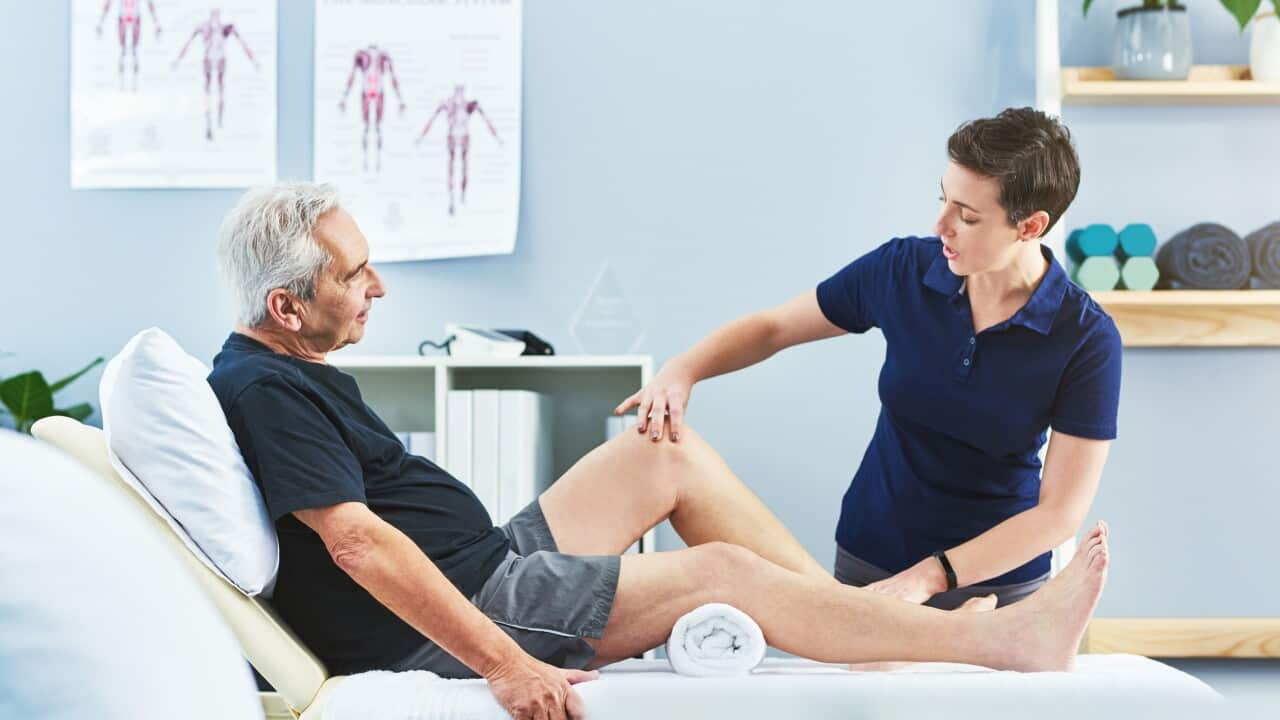bambae I helpem yu blong toktok, save mo konek taem yu stap long Ostrelia-
Ol lesen ia hemi blong olgeta we oli stap lanem Inglis lanwij long Medium level. Afta yu lisen, testem save blong yu wetem ol kwik tes blong mifala.
Learning notes
Language objective:
How to describe body pain.
Different phrases to use when describing your body pain:
- My back is killing me.
- The pain can transfer to my shoulders.
- It’s a nagging pain that doesn’t really go away.
- It’s definitely chronic.
- My leg muscles ached.
- It’s quite acute and intense.
- My knee often throbs.
Different phrases to use when asking someone about their body pain:
- Where does it hurt the most?
- How’s your leg?
- Is it a sharp pain or dull ache?
- Have you thought about seeing a physio?
Colloquial expressions:
It is killing me is an informal expression about anything that is causing pain – both physical and mental.
Vocabulary:
Ache means continuous pain in various body parts.
Acute pain means very painful and can be difficult to bear.
Chronic pain or chronic condition means a pain or condition that lasts for a long time and just won’t seem to get better.
Dull ache means a pain that usually lasts a long time but is not so strong.
Nagging pain means a pain that is there all or most of the time that might not be strong but is nonetheless uncomfortable and annoying.
Sharp pain means a pain that can feel like it is cutting into you, just like a sharp knife.
Sore means a generalised feeling of pain or discomfort.
Throbbing pain means a pain that feels like a rhythmic ache, like a heartbeat or pulse. It’s pain comes and goes in a pattern.
Cultural information:
Physio is a shortened word for a physiotherapist. According to Allied Health Professionals of Australia, physiotherapists assess, diagnose, plan and manage the care of patients across a broad range of areas with musculoskeletal, cardiothoracic and neurological problems.
Transcript:
(Note: This is not a word-for-word transcript)
SBS acknowledges the Traditional Custodians of Country and their connections and continuous care for the skies, lands, and waterways throughout Australia.
One day, I went to work but couldn't walk properly because I’d been to the gym the day before and different parts of my body were hurting after my workout.
When my colleagues asked me, I didn’t know how to describe the pain I was feeling.
All I could do was moan ... like arggh ... ahh ... ouch ...
That's when I realised this would be a good conversation for this podcast.
My name is TJ, and today I hope you are feeling relaxed and calm because in this episode, we’re going to learn how to talk about body pain.
But don't worry, we're not going to use complicated medical terms here. We’re just going to give you some simple ways to describe the different kinds of pain you might experience.
As usual, let’s start with our characters, Allan and Claire. This time, let’s imagine that they are both bus drivers and this afternoon, they are chatting after a long day at work.
Claire
Ugh, my back is killing me. I think it might be from sitting at the wheel for hours every day.
Allan
Oh no! Where does it hurt the most?
Claire
Mainly in my lower back. But sometimes, the pain can transfer to my shoulders as well. It’s a nagging pain; it doesn’t really go away.
Allan
You have been complaining about it for a while now …
Claire
Yes, I know. It’s definitely chronic, but I don’t seem to be able to do much about it. Oh, by the way how’s your leg? I remember you said it was sore last week.
Allan
Oh, that’s just because we did a long hike. My leg muscles ached for the next few days, but that’s faded now, thank goodness. Now I just have a pain in my knee.
Claire
Oh, that’s terrible. Knees are so important! Is it a sharp pain or a dull ache?
Allan
It’s quite acute and intense. My knee often throbs, especially after I’ve been driving for a long time.
Claire
Sounds awful. Have you thought about seeing a physio?
After listening to that conversation, it’s not my back that hurts, but my head. But there were a lot of useful words and phrases we can use to talk about pain.
Let’s hear them again.
First, Claire said ...
Ugh, my back is killing me. I think it might be from sitting at the wheel for hours every day.Claire
Claire said her back was killing her but don’t worry, it’s just an expression. We use it informally about anything that is causing pain – both physical and mental. For example, if your dog was being very annoying one day, you might say, “My dog is killing me! He won’t stop barking.”
Allan replied with ...
Oh no! Where does it hurt the most?Allan
When you are describing your pain to someone, it helps to do that in three different parts: where you are feeling it, how often or how long you have felt it, and what type of pain it is. First, where is the pain? Allan asked Claire “Where does it hurt the most?” to which Claire responded ...
Mainly in my lower back. But sometimes, the pain can transfer to my shoulders as well.Claire
Your "lower back" is the bottom part of your back. If the pain "transfers" from one place to another, it means that it moves to another part of your body.
Claire then describes how long she is has been experiencing it.
It’s a nagging pain; it doesn’t really go away.Claire
When someone describes the pain as "nagging", they are saying that the pain is there all the time or most of the time. It might not be very strong, but it can be annoying and make you feel uncomfortable.
She also used another term with a similar meaning ...
It’s definitely chronic, but I don’t seem to be able to do much about it.Claire
A "chronic" pain or condition is a pain or condition that lasts for a long time and just won’t seem to get better. We usually use the word "chronic" to describe something that won’t go away so that we may have to manage to live with it rather than expect an instant cure.
Oh, by the way, how’s your leg? I remember you said it was sore last week.Claire
When someone asks, "How's your leg?" they're checking to see if your leg is feeling okay.
You can use it for other parts of the body, too. For example, "How’s your back?" or "How's your neck?" or "How's your head?"
Claire described her leg as "sore." It could be sore or hurting because of things like using those muscles too much, getting injured, or having a medical issue.
"Sore" can also be used when you are describing pain in a particular area due to irritation or swelling like a sore throat or sore eyes.
Oh, that’s just because we did a long hike. My leg muscles ached for the next few days, but that’s faded now, thank goodness. Now I just have a pain in my knee.Allan
Have you heard the words "headache" or "backache" or "toothache"? The word "ache" is used to describe a continuous pain in various body parts.
So, the third part of describing pain is the feeling itself. This can be difficult because we all feel differently. But there are some words that are useful to know.
Let’s have a listen to some of the ways Allan and Claire describe their pain.
Oh, that’s terrible. Knees are so important! Is it a sharp pain or a dull ache?Claire
It’s quite acute and intense. My knee often throbs, especially after I’ve been driving for a long time.Allan
First, Claire asks if the pain is a "sharp pain". Just like a knife is sharp, a pain can feel like it is cutting into you. Allan said his pain was "acute and intense" which means that it is very strong. An "acute" pain is very painful and can be difficult to bear. If the pain is intense, then it is strong but may not be continuous.
A "dull ache", however, usually lasts a long time but is not so strong.
Allan also said that his knee throbs.
When someone says the pain is "throbbing", they feel a rhythmic ache like a heartbeat or pulse. It’s a pain that comes and goes in a pattern.
Sounds awful. Have you thought about seeing a physio?Claire
Claire suggested seeing a "physio", which is a shortened way of saying "physiotherapist". Keep listening, and our guest physiotherapist will explain what they do and how they can help with your body pain.
But first, let’s listen to the whole conversation between Allan and Claire one more time.
Claire
Ugh, my back is killing me. I think it might be from sitting at the wheel for hours every day.
Allan
Oh no! Where does it hurt most?
Claire
Mainly in my lower back. But sometimes, the pain can transfer to my shoulders as well. It’s a nagging pain; it doesn’t really go away.
Allan
You have been complaining about it for a while now …
Claire
Yes, I know. It’s definitely chronic, but I don’t seem to be able to do much about it. Oh, by the way, how’s your leg? I remember you said it was sore last week.
Allan
Oh, that’s just because we did a long hike. My leg muscles ached for the next few days, but that’s faded now, thank goodness. Now I just have a pain in my knee.
Claire
Oh, that’s terrible. Knees are so important! Is it a sharp pain or dull ache?
Allan
It’s quite acute and intense. My knee often throbs especially after I’ve been driving for a long time.
Claire
Sounds awful. Have you thought about seeing a physio?
RELATED CONTENT
Mind Your Health
Our colleague from SBS Australia Explained, Yumi Oba, spoke with a senior physiotherapist in Port Adelaide, Anna Fong, about what a physiotherapist is and how they are different from a chiropractor and an osteopath. Let’s have a listen ...
Yumi Oba
What exactly is a physiotherapist?
Anna Fong
That is a big question. Traditionally, physios work at undoing pain and body injuries, mainly things like sports injuries or age-related injuries or work posture issues, and anything that might have happened post-op (post-operation). Some doctors will operate, and they might be in need of a physiotherapist afterwards, so we do that as well. So, in a nutshell, physios will look at assessing, treating and rehabilitating people with pain or movement disorders.
Yumi Oba
What are the most common types of body pain that your patients complain about?
Anna Fong
They usually complain about lots of neck pain, shoulder pain, back pain, knee pain and wrist pain. They generally present with age-related conditions or sports-related conditions and work injuries. I also get a lot of children coming into the clinic. Children come in with injuries from sports and exercise.
Yumi Oba
What are your tips if you feel body pain?
Anna Fong
Initial stages, you would want to rest and ice your pain first. If, after two days of rest and ice, the pain is still there, I would suggest (seeing a) physio to get a better assessment and treatment done on the area.
So, we’ve just heard from a physio, but you might have also heard about chiropractors or osteopaths. These are all types of allied health professionals. To find out more about the different allied health services in your language, you can go to .
A big thank you to our educational consultant, Professor Lynda Yates.
Paul Nicholson and Lily O'Sullivan voiced the characters of Allan and Claire.
Sound effects credit: Pixabay







